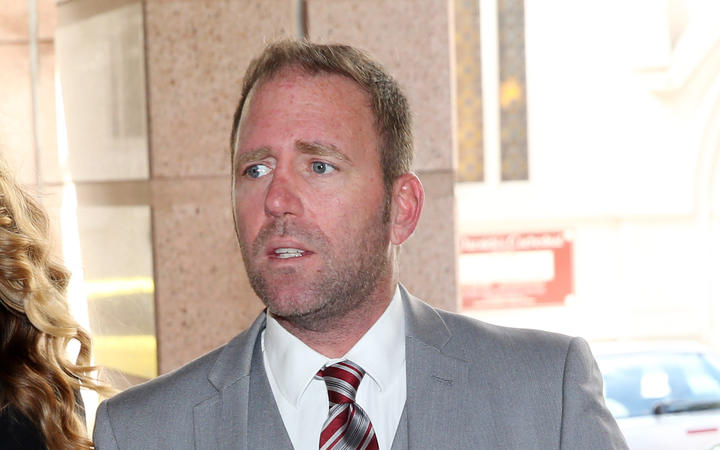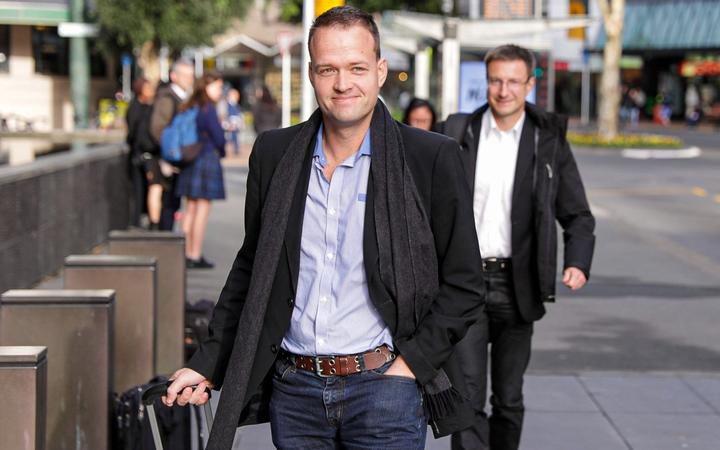
The Supreme Court hearing in respect of Kim Dotcom and his co-accused who face extradition to the United States has seen Dotcom’s former marketing manager Finn Batato finally appoint a lawyer to represent him.
But the lengthy last ditch attempt by the Dotcom team to avoid extradition to the US also saw the Supreme Court judges, including new Chief Justice Winkelmann and newly appointed Justice Joe Williams express their exasperation at the lawyers’ lengthy arguments.

Photo: AFP / Michael Bradley
Batato was arrested along with Dotcom and Bram van der Kolk and Mathias Ortmann, in January 2012.
The United States Department of Justice wants to extradite all four men to face criminal charges related to the Megaupload website.
Unlike his three co-accused, Mr Batato did not hold shares in the company.
Although his three co-accused have been represented throughout the various hearings, Batato has not, choosing to represent himself but has now appointed Auckland barrister Anthony Rogers to represent him in a hearing that has reportedly tested the patience of the Supreme Court judges.
“My concern is to focus on the position of Mr Batato, whose position I suspect has not been properly addressed by the courts below,” his lawyer told the Supreme Court, saying that his client had been unfairly swept up in the allegations. Balato had merely acted as an employee in the enterprise, he said.
The men have already lost appeals against that finding in the High Court and the Court of Appeal and are appealing to the Supreme Court this week
Rogers drew attention to a section of the Crimes Act defining who counts as a party to a crime and said the courts, including the Court of Appeal, had failed to consider Batato’s position in relation to that part of the law.
Last week, Canterbury University law professor and extradition law researcher Neil Boister told RNZ he thought it was unlikely the Supreme Court would consider each man’s eligibility for extradition separately.
It was more likely that Batato, if extradited, might be offered some kind of plea deal once he arrived in the US instead.
Dotcom lawyers try court’s patience
Lengthy arguments from Kim Dotcom’s team of lawyers stretched the patience of the five Supreme Court justices to breaking point on Wednesday afternoon.

Bram Van Der Kolk Photo: RNZ / Dom Thomas
At the beginning of the hearing on Monday, Dotcom’s lawyer Ron Mansfield and the lawyer for two of his co-accused, Grant Illingworth, (below) had agreed to limit their oral arguments to a day each.

The Illingworth’s arguments ran for all of Monday and well into Tuesday afternoon, and even with a slightly earlier start on Wednesday, Ron Mansfield also ran over time, creating some exasperation from the Judges.
After promising to finish by 3pm on Wednesday, Mr Mansfield was still on his feet at 3.15pm, prompting Chief Justice Helen Winkelmann to intervene.
“I’m asking you when you think you’ll be finished? Because we said an hour [after lunch].”
She was unimpressed when Mr Mansfield said he would be another 15 minutes: “Well, that will be an hour and a half.”
“At 3.30pm you’re going to be asked to sit down, Mr Mansfield,” Justice Winkelmann said. “I don’t want to be unduly harsh but this has to end some time.”
Justice Joe Williams also expressed impatience, asking Mansfield to provide a written list of references rather than insisting on reading them out to the court.
As Mansfield concluded his submissions, Justice Williams jokingly informed him he still had one minute left.
Unable to let the opportunity slip by, Mr Mansfield stayed at the lectern to labour one final point, which turned out to be an argument that the court had already refused to hear him on.
He concluded his submissions at 3.33pm.